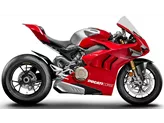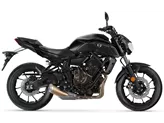Yamaha R1 2016 vs. Yamaha YZF-R6 2017

Yamaha R1 2016

Yamaha YZF-R6 2017
Vue d’ensemble - Yamaha R1 2016 vs Yamaha YZF-R6 2017
The Yamaha R1 model year 2016 and the Yamaha YZF-R6 model year 2017 are both supersport motorcycles manufactured by Yamaha. While they share some similarities in terms of design and features, there are also notable differences between the two models.
In terms of engine specifications, the Yamaha R1 2016 is equipped with a 998cc engine, whereas the Yamaha YZF-R6 2017 has a smaller 599cc engine. The R1 boasts a higher engine power of 200 horsepower compared to the YZF-R6's 124 horsepower. Additionally, the R1 has a higher torque of 112.4 Nm compared to the YZF-R6's 65.7 Nm. Both models have a compression ratio of 13 and feature four cylinders with four valves per cylinder. The engines of both models are equipped with DOHC technology.
In terms of suspension, both the Yamaha R1 2016 and the Yamaha YZF-R6 2017 feature upside-down telescopic forks in the front. This allows for better handling and stability while riding. The chassis of both models is made of aluminum and features a Deltabox frame, which provides strength and rigidity.

Yamaha R1 2016
Both models are equipped with double disk brakes in the front, ensuring strong and reliable stopping power. The front tire width of both models is 120 mm, with a diameter of 17 inches. However, the rear tire width of the Yamaha R1 is slightly wider at 190 mm compared to the YZF-R6's 180 mm. Both models have a rear tire diameter of 17 inches.
In terms of dimensions and weights, the Yamaha R1 has a wheelbase of 1405 mm, while the YZF-R6 has a slightly shorter wheelbase of 1375 mm. The seat height of the R1 is 855 mm, slightly higher than the YZF-R6's 850 mm. Both models have a fuel tank capacity of 17 liters.

Yamaha YZF-R6 2017
Now let's discuss the strengths and weaknesses of each model. The Yamaha R1 2016 is praised for its lively handling, high-revving and precisely controllable engine, and excellent electronics package. On the other hand, it is worth noting that the R1's shift assistant is only available for upshifting, which may be seen as a weakness by some riders.
The Yamaha YZF-R6 2017, on the other hand, is commended for its strong and direct brakes, sharp looks, automatic gearshift, good wind protection, precise handling, and high transparency. However, some riders may find the radical seating position of the YZF-R6 unsuitable for touring. Additionally, the standard power of the YZF-R6 is lower at 118.4 horsepower compared to the R1, and upgrading the power can be cost-intensive.
In conclusion, both the Yamaha R1 2016 and the Yamaha YZF-R6 2017 are high-performance supersport motorcycles with their own unique strengths and weaknesses. The R1 offers a more powerful engine and a wider rear tire, while the YZF-R6 provides strong brakes, a sleek design, and an automatic gearshift. Ultimately, the choice between the two models depends on the rider's preferences and intended use.
Caractéristiques techniques Yamaha R1 2016 par rapport à Yamaha YZF-R6 2017
Avantages et inconvénients en comparaison
Avantages et inconvénients en comparaison
Yamaha R1 2016

La fusée high-tech de Yamaha est toujours à la pointe de la technologie en 2016. Radicale, polarisante et fascinante, elle réalise de puissants temps au tour. Elle est plus proche des motos de course que les autres 1000. Entre-temps, personne ne se plaint de l'avant. Sans "M", elle est le meilleur choix pour ceux qui n'ont de toute façon pas besoin d'Öhlins ou le meilleur choix pour ceux qui prévoient de toute façon une transformation sur circuit et qui aiment monter du matériel Öhlins "normal", sans truc électrique.
Yamaha YZF-R6 2017

La Yamaha R6 2017 reste une moto supersport radicale tant sur le plan visuel que sur celui de la dynamique de conduite, l'une des meilleures et probablement la dernière du genre. La norme EURO4 coûte au quatre cylindres en ligne de 599 centimètres cubes avec soupapes en titane pas moins de 11 chevaux par rapport au modèle de 2007/2008. Mais Yamaha s'adresse clairement aux pilotes amateurs et professionnels sur circuit qui ne se soucient pas des performances de série. Avec plus de 50 accessoires, la R6 peut être améliorée en fonction des besoins et du budget. Mais chacun devrait être conscient que cela peut coûter cher.
Comparaison des prix Prix moyen du marché Yamaha R1 vs Yamaha YZF-R6
There are a few key differences between a Yamaha R1 2016 and a Yamaha YZF-R6 2017. There are the same number of bikes of both models available on the 1000PS.de marketplace, specifically 6. It takes less time to sell a Yamaha R1 with 73 days compared to 136 days for a Yamaha YZF-R6. Since model year 2005 1000PS.de editors have written 80 reviews for the Yamaha R1 and 33 reviews for the Yamaha YZF-R6 since model year 2005. The first review for the Yamaha R1 was published on 4/28/2003 and now has more than 3,900 views. This compares to more than 3,600 views for the first review on Yamaha YZF-R6 published on 10/17/2002.






















